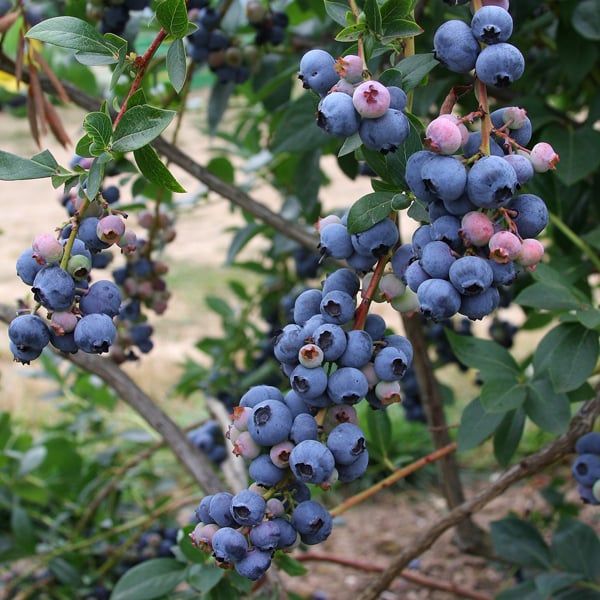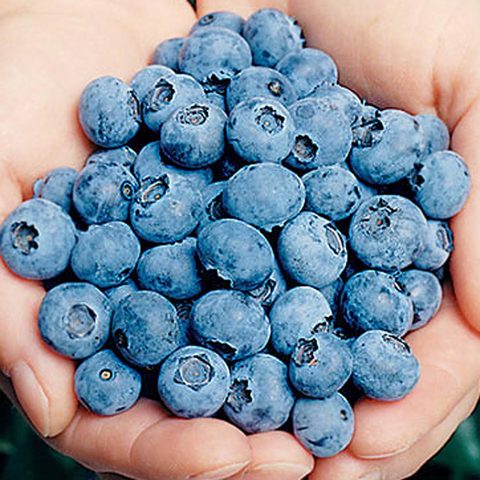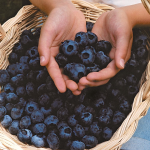How to Grow Blueberries (Vaccinium)

If you’ve ever dreamed of picking fresh fruit from your own backyard, consider planting Blueberries. Vaccinium, commonly referred to as Blueberry bushes, are among the easiest fruiting plants to grow and, with multiple varieties available, can be grown successfully in all USDA Hardiness Zones within the continental US. After they reach maturity, which may take up to two years, Blueberry plants provide bountiful berry harvests all season long. While you may need to take measures to protect your Blueberries from birds, who like to make a meal of the ripe berries, the plants are resistant to most other common pests.
In addition to providing succulent fruits, Blueberry bushes make an excellent addition to any landscape design. In the spring, they brandish deep green leaves accompanied in late spring by clusters of delicate white flowers. The flowers give way to small green berries which turn deep indigo as they grow and ripen through the summer. In the fall, their foliage provides one final show as it turns a dazzling shade of crimson before the plant goes dormant for the winter.
Planting Blueberry Bushes
Timing: Blueberry bushes can be planted in early to mid-spring, after the final frost. In warmer climates (Zone 6 and above), they may also be planted in late fall. Note that some varieties need a chilling period in winter, so be mindful when selecting a variety for your zone (particularly if you live in the South).
Location: Blueberries thrive in full sun but are sensitive to strong winds. This versatile plant will grow in the ground or in a container, offering the gardener flexibility when considering the best location. When deciding where to plant Blueberries in your yard, select a location that receives ample sunlight, and avoid placing them too close to tall trees or buildings. Planting multiple Blueberry bushes in a patch or alongside other shrubs can help shield the plants from wind damage.
Spacing: Plant Blueberry bushes about 4–5′ apart. Blueberry plants grow best in patches with multiple varieties so that the plants can cross-pollinate and support one another in windy conditions. If planting multiple rows, allow about 9–10’ between rows for easier berry harvesting.
Depth: The root ball of your Blueberry plant should be no more than ½” below the surface of the soil. Consider the size of your plant and whether it is potted or bareroot to determine how deep to dig, backfilling as necessary to achieve the correct depth.
Soil: Blueberries flourish in acidic soil that is moisture-retentive yet well drained. A soil pH of 4.5–4.8 is preferable.
If you are planting Blueberry bushes directly in the ground, test your soil first to check the pH, amending with soil acidifier or lime as directed, if necessary. You can contact your local county cooperative service for help with soil testing or you can test it yourself with our Soil Ph Meter.
Dig a hole twice the width and the same depth as the root ball of each plant. Because Blueberries grow best in soil that is rich in humus, remove about half of the soil dug from the planting hole and replace it with at least as much peat moss. Mix the peat moss thoroughly into the remaining soil before pushing it back into the hole. Surrounding your plants with a 4–5′ circle of mulch helps keep the soil moist and prevents the growth of weeds.
Companion Plants: You can plant Blueberries with other acid-loving companions such as::
Growing Blueberry Plants in Pots
Blueberry plants can be grown in containers easily, with a few minor adjustments. Select a weatherproof container at least 1’ deep and 2’ in diameter, with drainage holes. As the plant grows, you may need to repot it in a larger container; each spring, assess your plants and repot them when necessary.
To grow Blueberries in pots, use a well-draining, acidic soil designed for container gardening. A thick layer of mulch atop the soil can aid in moisture retention. Water regularly, applying water directly to the soil around the plant. The Blueberry plant’s leaves can act like umbrellas and prevent water from reaching the soil, so never assume that the plant is getting water when it rains. Throughout the spring and summer, check the soil every few days, watering when the top 1” feels dry. In fall and winter when the plant has become dormant, it requires significantly less water. Check the soil monthly and provide water as needed.
In Zones 5 and below, plants grown in containers require extra cold-weather care to protect their roots. The most common solution is to temporarily plant them in the yard, either removing the plant from its container first or sinking the entire container into a large hole. In early spring, dig up the plant and place it back in its container, or dig up the entire container and proceed as usual with plant care.
If you do not have space to bury your Blueberry Plants, here are a few alternatives : If possible, move the plant to any non-south-facing side of the house, shed, or fence and surround the container with mulch, shredded leaves, pine straw, or burlap to insulate the roots. Another option is to move the plants to an unheated shed, garage, or basement during extreme cold spells, being mindful not to expose the plants to too much sunlight or heat, as this can stimulate active growth during a period when the plants need to remain dormant. If the containers are too large to move, insulate them in place by heavily mulching the top of the soil and wrapping the container in 3–4 layers of heavy-duty burlap or bubble wrap.
Blueberry Bush Care
Watering: Blueberry plants require about 1″ of water per week. Because of their shallow root system, they prefer to receive water slowly—drip irrigation is ideal for this reason.
Fertilizing: Do not fertilize Blueberry bushes for one year after planting. After that, use a fertilizer formulated for acid-loving plants twice each year: first in the spring at flowering time and again about four weeks later.
Pruning: Pruning Blueberry bushes engenders healthy growth and fruitful harvests. The first spring after planting, remove all flowers the plant produces. Sacrificing the beautiful blooms encourages the plants to grow healthier and will reward you with a greater yield of berries.
After the first year, Blueberries have modest pruning needs. In early spring, remove any branches that are damaged, weak, or over-crowded.
As the plant matures, prune dead wood and low spreading branches in the early spring. Limit the number of major branches arising from the base to 8–10. Regularly remove branches that are more than 4–5 years old to allow younger branches to take their place.
Pests: Though there are some insects and diseases which might pose a threat to your Blueberry plants under certain weather conditions, they’re generally resistant to most pests. But birds have a particular affinity for their ripe berries. If you find that your blueberries are going to the birds, using a natural deterrent such as wind chimes or motion-activated sprinklers may help keep them at bay. For more aggressive avians, the only sure way to protect your crop is to cover your plants—individually or as a group—with netting. Support the netting above the Blueberry Bushes with wooden posts and tie it at the base to keep birds from reaching the fruit.
Harvesting: Blueberry bushes begin bearing fruit the second year from planting. Within 6 to 8 years, the plants will reach maturity and abound with juicy berries. Most varieties produce fruit for a few months each year, with peak production between June and August. When berries are ripe and ready to harvest, they will fall easily from their stems with little resistance. Berries turn blue a few days before they are fully ripe, so check plants every few days; if harvested too early, the fruit will be bitter, whereas ripe berries will be sweet and succulent.
Troubleshooting
Yellow Leaves: If your Blueberry bush has yellow leaves, this is generally a sign that the soil pH is too high. Test the soil and amend it as necessary to achieve a pH between 4 and 5.
Red Leaves: It is normal for Blueberry leaves to turn red in the fall. But if leaves are turning red in the spring, when they should be green, this can be a sign of a problem with your plant. The most common issues stem from incorrect soil pH or poor drainage. Ensure there is proper drainage and water is not pooling around your plant. Have the soil checked, amending it as necessary to achieve the correct pH.
Brown Leaves: If a Blueberry plant does not receive enough water, the leaves will turn brown and shrivel. Younger plants are especially susceptible to dehydration, as their roots are shallower and cannot access moisture as easily. Other less common causes of leaf browning are insufficient sunlight or incorrect soil pH. Ensure your plant receives at least 6 hours of sunlight each day and have the soil checked, amending it as necessary.
Red Spots on Leaves: Blueberry plants with red spots on the leaves are suffering from the red ringspot virus. Remove all infected parts of the plant immediately to prevent the virus from spreading.
Blueberry Plant Not Flowering: Blueberry plants thrive when given the appropriate amounts of water, soil, and sunlight. If your plant is not flowering, it is a sign that one or more of the growing conditions is not correct. Review recommendations above and modify accordingly.
Blueberry Plant Not Fruiting: If a Blueberry plant is not producing berries, this is typically a sign that the plant is not receiving sufficient sunlight. It could also indicate that the plant is not being pollinated; while most Blueberry plants are self-pollinating, they will produce much more abundant yields of fruit if cross-pollinated with 2–3 different plant varieties.
Frequently Asked Questions
How long does it take for Blueberries to grow?
Most Blueberry bushes begin bearing fruit the second year from planting, with peak harvests after about 6–8 years.
Where do Blueberries grow?
With multiple varieties available, Blueberries can grow everywhere in the continental US. Select a type that is suited for your Zone for best results.
How big do Blueberry bushes get?
Blueberry bushes can grow anywhere from 1–12’ high depending on the plant type. The four primary Blueberry varietals and their maximum heights are as follows:
- Northern Highbush: 6–12’
- Southern Highbush: 1–4’
- Lowbush: 2–24”
- Rabbiteye: 3–6’






